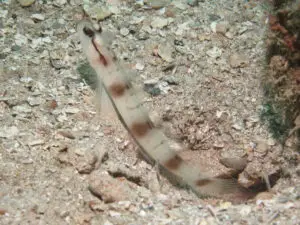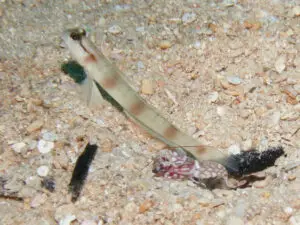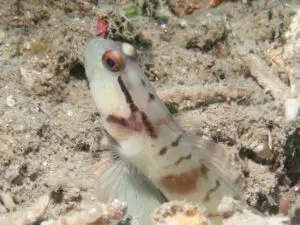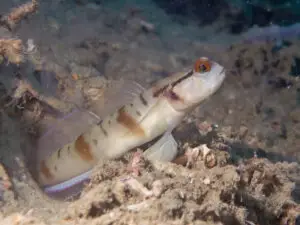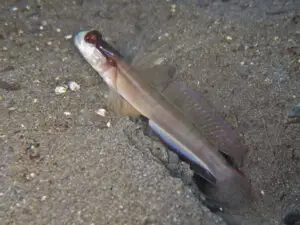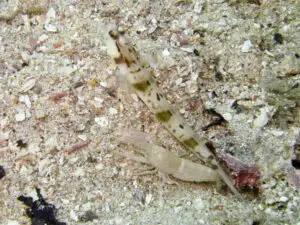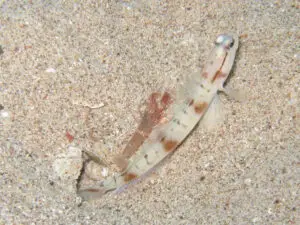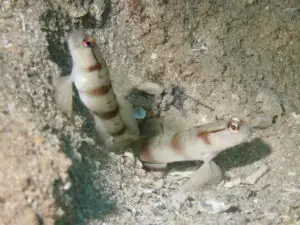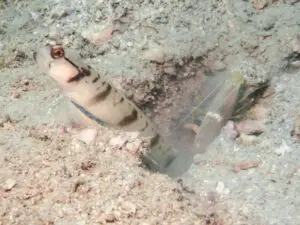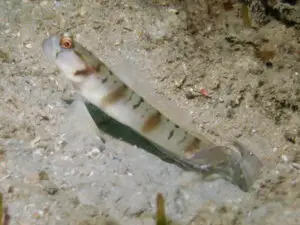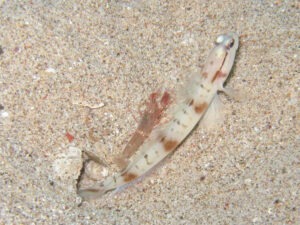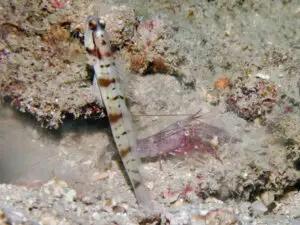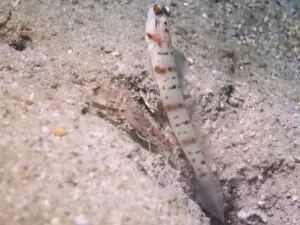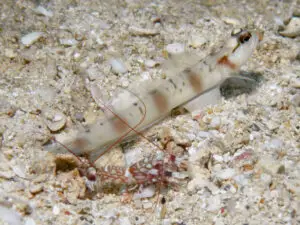Mask Shrimpgoby
Amblyeleotris gymnocephala

Mask Shrimpgoby
Amblyeleotris gymnocephala
(Bleeker, 1853)
Description
Body design This is a somewhat slender elongated medium sized goby, up to 14 cm in length, tan coloured with five widely spaced diffuse brown bars, the last on the base of the tail and the first incorporated into the eye stripe. Between these bars there is coarse speckling dorsally.
Head There is a dark brown stripe running from behind the eye to the upper edge of the gill cover, and a fine brown bar below the eye. These are highlighted by reflective blue dots and dashes, otherwise there is no facial ornamentation. The lines around the eye may not be visible, which makes identification more difficult.
Fin design
First dorsal fin
Second dorsal fin
Caudal fin
Pelvic fin
Anal fin
Pectoral fin
The fins are transparent apart from the anal fin which has a blue and purple border.
Influence of habitat On darker sand the colour of the pigmented areas is intensified and the head markings more reliable, On some occasions the fish takes on a very dark brown hue and the bars are obscured making it look very different.
Diagnostic features
The narrow elongated body with widely spaced brown bars is distinctive. The markings around the eye are the most useful feature, but are sometimes not easy to discern.
Similar species
Amblyeleotris gymnocephala has a superficial similarity to others of its genus such as Amblyeleotris rubrimarginata, Red-margin Goby and Amblyeleotris steinitzi, Steinitz’s Goby but the line running behind the eye is distinctive. There is a similar line behind the eye in Amblyeleotris macronema but the fin design is very different.
Natural History
Habitat
Found in 5 to 35 metres on a wide range of habitat, usually the flat sand base of sheltered bays, lagoons and channels, often tolerating strong tidal currents. They also may be found in sandy shell grit patches between rocky outcrops and on sand flats some distance out from fringing reefs. Some are found in sparse seagrass patches. Suitable substrate varies from clean sand to silty sand and water clarity from clear to quite low visibility.
We have not seen this shrimpgoby at Lizard Island or the outer Great Barrier Reef.
Behaviour
They perch in a conspicuous manner near the burrow keeping a lookout for small crustacea or other food that may come by. They are fairly approachable but wary about being photographed, going into contortions at the strobe flash. Despite the retreat being initiated by the fish the shrimp’s reflexes are so fast that it arrives at the burrow first as shown in this image. The shrimp is blurred although the photo is taken at 1/800th of a second.
They have typical shrimpgoby behaviour guarding the burrow entrance, catching small invertebrates and interacting with their partner shrimps.
They accompany the shrimp when foraging but we have seen them break the contact without evident reason leaving the shrimp alone.
They are described as amphidromous (start life in freshwater, move to salt, return to fresh) in Fishbase. We are unclear what this refers to. They are reported to live in mangroves but we have not seen them in this habitat. We have seen them below a rainforest-fringed shallow seawater passage leading to Kabui Bay in eastern Indonesia.
Distribution
Published distribution:
Eastern Indonesia and North Western Australia to Marshall Islands.
Our records:
Indonesia, Solomon Islands, Papua New Guinea and Australia: Fitzroy Island and Low Isles.
Associated Shrimps
7 species
Associated Shrimps (seven shrimps)
Brown Pyjama Snapping Shrimp, Alpheus ochrostriatus
Grey Snapping Shrimp, Alpheus species 5
Pink Pyjama Snapping Shrimp, Alpheus ochrostriatus complex
Red Pyjama Snapping Shrimp, Alpheus ochrostriatus complex
Red Snapping Shrimp, Alpheus species 9
Red-Speckled Snapping Shrimp, Alpheus species 10
Tiger Snapping Shrimp, Alpheus bellulus
It is hard to say if any shrimp is the primary host as the Mask Shrimpgoby occupies so wide a range of habitat and the shrimp association is determined by the substrate.

